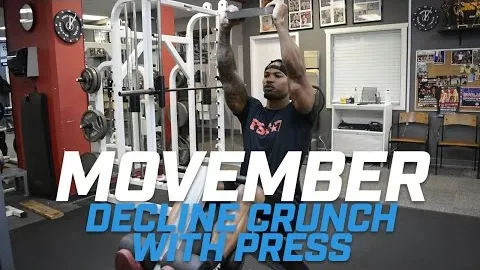
Are you looking to take your fitness routine to the next level? If so, the decline crunch with press exercise might be just what you need. This versatile movement targets not only your core muscles but also works to improve your upper body strength. In this article, we'll explore the benefits of this exercise, how to perform it correctly, and provide tips for adding it to your workout routine.
The decline crunch with press is a compound exercise that combines two movements: the traditional decline crunch and the dumbbell press. By performing these two exercises together, you can maximize your workout efficiency and see results faster. Here are some of the key benefits of incorporating this exercise into your routine:
1. Strengthening Core Muscles: The decline crunch primarily targets your rectus abdominis, which is responsible for giving you those coveted six-pack abs. By adding the press movement, you engage your obliques, transverse abdominis, and even your lower back muscles, leading to a stronger and more defined core.
2. Improving Upper Body Strength: The dumbbell press component of this exercise engages your chest, shoulders, and triceps, allowing you to build muscles and increase your upper body strength. This makes the decline crunch with press a great choice for individuals looking to enhance their overall upper body power and muscularity.
3. Enhancing Stability and Balance: Performing the decline crunch with press on an inclined bench adds an extra level of difficulty to the exercise by requiring your body to stabilize itself. This improves your overall stability and balance, making everyday activities easier and reducing the risk of injuries.
4. Increasing Caloric Expenditure: As a compound movement that engages multiple muscle groups simultaneously, the decline crunch with press can help you burn more calories compared to isolated exercises. Incorporating this exercise into your workout routine can assist in weight management and fat loss.
To perform the decline crunch with press exercise correctly, follow these step-by-step instructions:
Here are some important tips to keep in mind when adding the decline crunch with press exercise to your workout routine:
Start with a light weight: If you're new to this exercise, begin with lighter dumbbells to ensure proper form and avoid injury. As you become more comfortable with the movement, gradually increase the weight to continue challenging your muscles.
Focus on quality over quantity: It's important to perform each repetition with proper form and control. Avoid rushing through the exercise and prioritize the mind-muscle connection.
Proper breathing technique: Exhale as you lift your upper body off the bench and extend your arms upward. Inhale as you lower your upper body back down and return the dumbbells to the starting position. This breathing pattern helps stabilize your core and optimize your performance.
Gradually increase intensity: Once you have mastered the movement, you can add intensity to the exercise by increasing the weight, the number of repetitions, or decreasing the rest time between sets. This progression ensures continued muscle growth and strength development.
The decline crunch with press is an effective exercise for strengthening your core muscles and improving upper body strength. By incorporating this compound movement into your workout routine, you can take your fitness goals to the next level. Remember to perform the exercise correctly, focus on proper form and control, and gradually increase the intensity as you progress. With consistency and dedication, you will soon experience the benefits of this exercise firsthand. So, why not give it a try and challenge yourself today?
If you're looking for a gym, fitness club or yoga studio, you've come to the right place.
You can find information about gyms in your area. Browse catalog of gyms and find gyms with classes which are you looking for.
On gym page you can find simple information like address, phone or website. You can find list of available classes. You can check availability of personal training or small group classes. On place page you can also see information about open hours.
You can find gyms near you with amenities, courts, studios and equipments.
Use our map to find gym at your city or district.
In Gym Navigator you can find list of exercises with movies for many body parts.
You can browse exercises catalog and find exercises the best of you.
You can also find exercises grouped into workout plans, which you can use to improve you body. Each routine show you exercises one by one and give you possibility to count you progress and count down rest time.